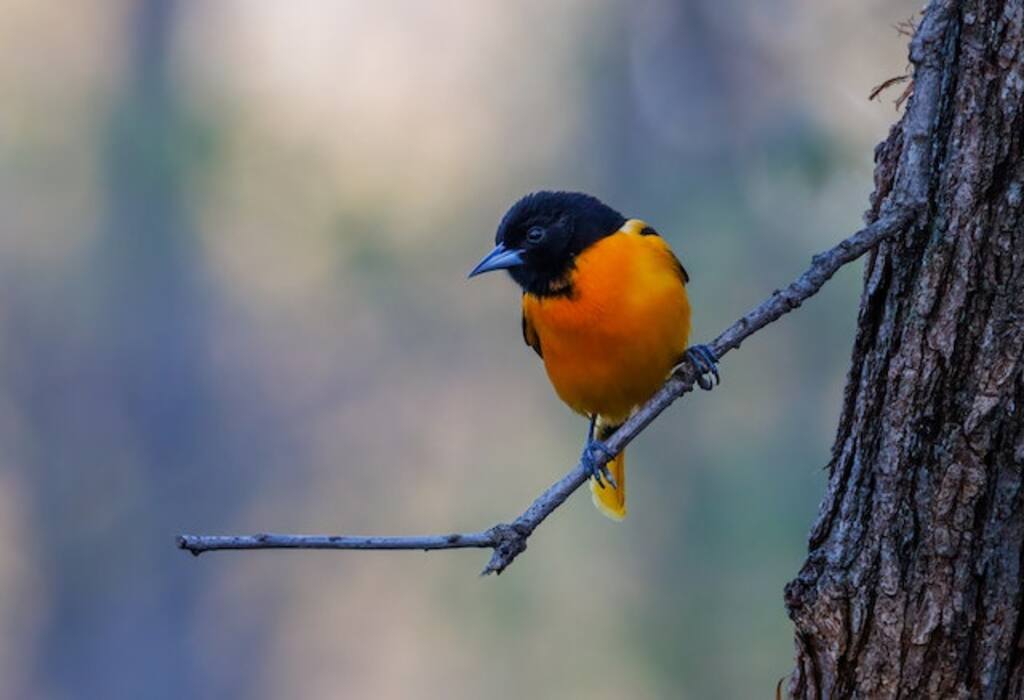Calling all bird enthusiasts! Baltimore Orioles, known for their vibrant plumage and melodic tunes, are a common sight in gardens and backyards. But here’s the juicy question: Do Baltimore Orioles feast on strawberries?
Join us as we uncover the dietary secrets of these delightful birds, their penchant for insects, nectar, and… strawberries?
We’ll dive into their preferences, shed light on the allure of strawberries, and share tips on feeding these feathered friends and other bird species. Get ready for a berry delightful revelation!
Table of Contents
- 1 Overview of Baltimore Orioles
- 2 Baltimore Orioles’ Diet
- 3 Strawberry Plants
- 4 Do Baltimore Orioles Eat Strawberries?
- 5 Other Birds That Eat Strawberries
- 6 Benefits of Feeding Baltimore Orioles
- 7 Precautions When Feeding Baltimore Orioles
- 8 Conclusion
- 9 Frequently Asked Questions
- 9.1 What is the average lifespan of a Baltimore Oriole?
- 9.2 How do Baltimore Orioles migrate and where do they go?
- 9.3 What other types of food do Baltimore Orioles eat besides strawberries?
- 9.4 How can you attract Baltimore Orioles to your backyard?
- 9.5 Are Baltimore Orioles considered threatened or endangered species?
- 10 Overall Conclusion
- 11 Author
Overview of Baltimore Orioles
The Baltimore Oriole is a brightly colored bird native to North America with a distinct song and unique nesting habits.
These birds are commonly found in deciduous forests, orchards, and gardens throughout the eastern United States and southern Canada.
During the breeding season, they build their nests in the upper branches of trees using a unique weaving technique.
Baltimore Orioles migrate to their breeding grounds in late April and May, with males arriving first to establish territories before the females.
They typically migrate to Central America and northern South America for the winter. Understanding the habitat and migration patterns of Baltimore Orioles is crucial for conservation efforts.
Now, let’s explore the Baltimore Orioles’ diet and whether they eat strawberries.
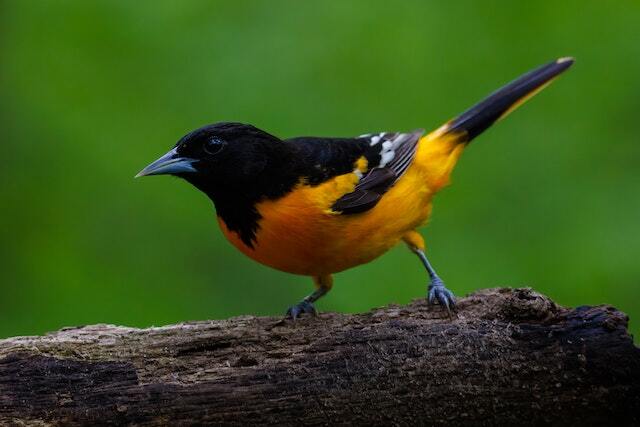
Baltimore Orioles’ Diet
The diet of Baltimore Orioles includes a variety of fruits, insects, and nectar. These birds are known to consume insects such as ants, caterpillars, beetles, and spiders, which make up a significant portion of their diet.
During the breeding season, they also feed on nectar from flowers, particularly those of trumpet creeper and jewelweed.
Baltimore Orioles are migratory birds that travel between their breeding grounds in North America and their wintering grounds in Central America and northern South America.
Their migration patterns are closely linked to the availability of food along their route.
While Baltimore Orioles are not known to specifically eat strawberries, they may occasionally feed on ripe fruit, including berries, if they come across them in their foraging.
Now let’s move on to explore the question of whether Baltimore orioles eat strawberries.
Strawberry Plants
Strawberry plants are a common garden crop that require adequate sunlight and well-draining soil to thrive. Growing strawberries can be a rewarding experience, but it’s important to take care of the plants and protect them from pests.
Some effective methods of pest control for strawberry plants include using row covers, introducing beneficial insects like ladybugs and lacewings, and regularly inspecting the plants for signs of damage.
By taking these steps, gardeners can ensure that their strawberry plants are healthy and productive.
But the question remains: do Baltimore Orioles eat strawberries?
Do Baltimore Orioles Eat Strawberries?
Yes, Baltimore Orioles are known to eat strawberries. These juicy fruits are among the many delicious treats that these colorful birds enjoy as part of their omnivorous diet.
So, if you spot these winged visitors in your garden, don’t be surprised if they’re indulging in some sweet strawberry delights!
Research on Baltimore Orioles’ Eating Habits
What is the dietary preference of the Baltimore Oriole, and how does it obtain its primary source of sustenance?
The Baltimore Oriole is known to have a diverse diet, feeding on insects, nectar, fruits, and occasionally seeds. During migration, they rely heavily on fruit as a source of energy.
Their feeding habits are also influenced by climate change, which can affect the availability of their preferred food sources.
As temperatures rise, the timing of fruit ripening can shift, leading to mismatches between the bird’s arrival and the availability of food.
Despite these challenges, the Baltimore Oriole has shown adaptability in its feeding behavior, with studies indicating that they are able to switch to alternative food sources when their preferred options are scarce.
This adaptability has been attributed to their highly flexible bill morphology.
In conclusion, the Baltimore Oriole’s feeding habits are complex and influenced by various factors. Understanding their dietary preferences and adaptability is crucial in developing effective conservation strategies.
The next section will delve into experimentation to gain further insights into their behavior.
Experimentation
The experimentation section presents an opportunity to gain deeper insights into the feeding behavior of the Baltimore Oriole through controlled observations and data collection. To achieve this goal, the following items need to be considered:
1) Identifying possible variables that may influence the Baltimore Oriole’s feeding behavior, such as the availability of other food sources, the time of day, and the location of the feeding area;
2) Setting up a controlled environment where the Baltimore Oriole’s feeding behavior can be observed and recorded systematically;
3) Collecting data on the frequency and duration of feeding, the types of food consumed, and any changes in behavior that may occur during the experiment;
4) Analyzing the data collected to identify patterns and draw conclusions about the Baltimore Oriole’s feeding behavior.
By conducting this experiment, we can gain a better understanding of the factors that influence the Baltimore Oriole’s feeding habits and potentially discover whether they eat strawberries or not.
Moving forward, we will explore other birds that eat strawberries and compare their feeding behavior to that of the Baltimore Oriole.
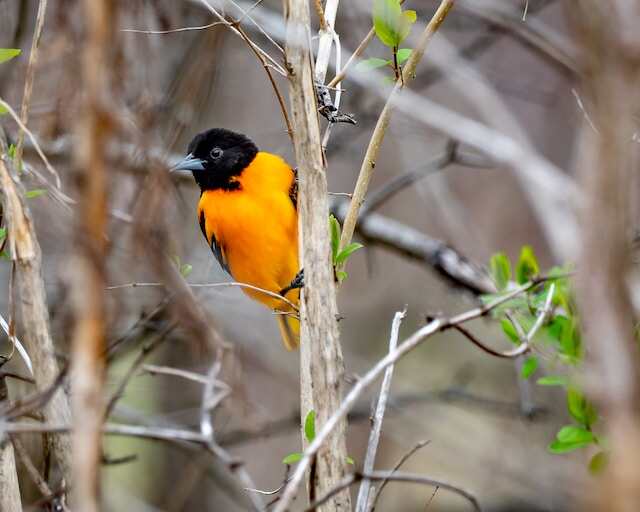
Other Birds That Eat Strawberries
Birds from various species enjoy consuming strawberries, making it a popular fruit among avian creatures. While Baltimore Orioles are known to prefer insects and nectar, there are other bird species that have been observed consuming this sweet fruit.
Some of these species include American Robins, Cedar Waxwings, Northern Mockingbirds, and Gray Catbirds.
These birds are commonly found in gardens and orchards, where they can easily access strawberries and other fruits.
Garden protection methods such as netting or scarecrows can be used to prevent birds from consuming all the fruit, but it is important to note that birds play a vital role in pollination and ecosystem balance.
Providing a source of fruit for birds can also attract them to your garden, which can have many benefits. In the next section, we will explore the benefits of feeding Baltimore Orioles.
Benefits of Feeding Baltimore Orioles
Feeding a specific species of bird can provide numerous benefits to the environment and enhance the overall ecological balance.
When it comes to Baltimore Orioles, feeding them can be a great way to attract these beautiful birds to your yard and provide them with much-needed nourishment.
Here are some tips for attracting them and creating DIY feeders:
- Plant fruit-bearing trees and shrubs in your yard, such as mulberry, blackberry, and elderberry bushes.
- Use a jelly feeder to offer grape jelly or orange marmalade, which are favorite foods of Baltimore Orioles.
- Offer fresh, ripe oranges and sliced grapefruit on a platform feeder.
- Create a DIY Oriole feeder using an orange or grapefruit peel, by scooping out the flesh and filling it with jelly or nectar.
It is important to note that Baltimore Orioles have a seasonal feeding schedule, with their migration period from mid-April to early May. During this time, it is crucial to offer them plenty of nourishment to help them on their journey.
Additionally, when feeding Baltimore Orioles, be sure to take precautions to avoid attracting unwanted pests, such as ants and wasps.
With these tips, you can create a welcoming environment for Baltimore Orioles in your yard and contribute to the balance of nature.
In the next section, we will discuss precautions to take when feeding Baltimore Orioles.
Precautions When Feeding Baltimore Orioles
When feeding Baltimore Orioles, it is important to take certain precautions to ensure the birds’ health and safety.
First and foremost, avoid using pesticides or other harmful chemicals near the feeding area.
Additionally, proper placement of feeders is crucial to prevent predators from accessing the food and endangering the birds.
Finally, regular cleaning of feeders is essential to prevent the spread of disease among the birds.
By following these guidelines, bird enthusiasts can create a safe and healthy environment for Baltimore Orioles to thrive.
Avoiding Pesticides
Minimizing exposure to harmful chemicals is important for maintaining a healthy ecosystem and promoting sustainable agricultural practices.
This is particularly crucial when feeding Baltimore Orioles, as they are highly sensitive to pesticides and other toxic chemicals.
To avoid harming these birds, it is important to opt for pesticide-free farming and organic gardening practices when cultivating the fruits and vegetables that they consume.
This will help ensure that the food they eat is free from dangerous chemicals and contaminants. By doing so, we can promote a healthy ecosystem that supports the natural feeding habits of these birds.
Proper placement of feeders is also important to ensure that Baltimore Orioles can access their food safely and without unnecessary risks.
Proper Placement of Feeders
To ensure that Baltimore Orioles have a safe and enjoyable feeding experience, proper feeder placement should be considered.
Bird behavior should be taken into account when choosing a feeder location. The following four factors should be considered when deciding on a feeder placement location:
- Keep feeders away from windows to prevent bird collisions.
- Place feeders in a shaded area to keep the nectar fresh and prevent it from spoiling too quickly.
- Place feeders away from areas that may attract predators, such as cats.
- Position feeders in a quiet area to prevent birds from becoming startled or scared.
By taking these factors into consideration, bird enthusiasts can help ensure that Baltimore orioles have a positive feeding experience, while also encouraging them to return.
Once feeders are properly placed, it is important to also maintain them by cleaning and sanitizing them regularly.
Cleaning Feeders
Like a well-oiled machine, proper cleaning of feeders is an essential component to ensuring the long-term health and satisfaction of the feathered visitors.
Feeder maintenance is crucial in preventing the spread of disease and keeping the feeding area hygienic.
It is recommended to clean feeders at least once a month with hot soapy water and a brush, and to let them dry completely before refilling them with fresh food.
Additionally, pest control is another important aspect of feeder maintenance. Ants, squirrels, and other unwanted visitors can be deterred with specialized feeders or by placing a baffle or barrier around the feeding area.
By regularly cleaning and maintaining feeders, bird enthusiasts can attract a variety of feathered friends while also ensuring their health and safety.
As we conclude this discussion, it is important to note that proper feeder maintenance is just one aspect of creating a welcoming environment for birds.
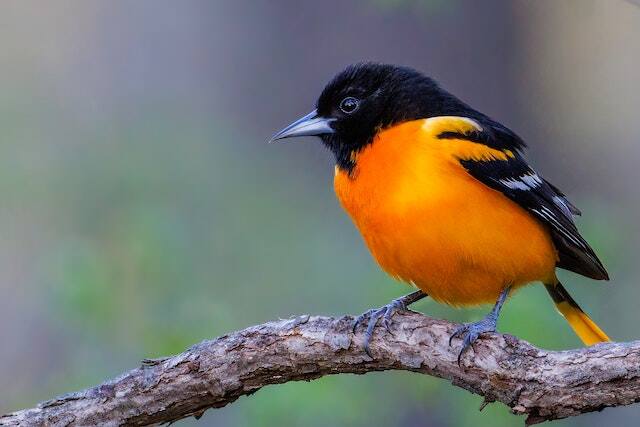
Conclusion
Based on the available information, it can be inferred that there is a correlation between the dietary habits of Baltimore Orioles and certain types of fruits.
While it is not clear whether orioles specifically eat strawberries, it is known that they are attracted to a variety of fruits such as oranges, grapes, and apples.
Offering these alternative fruits, along with the benefits of feeding, can not only attract orioles but also provide them with essential nutrients.
Additionally, keeping feeders clean and free of mold can prevent illness in birds, ensuring a healthy and sustainable feeding environment.
As research into the feeding habits of Baltimore Orioles continues, it is important to consider the impact of different types of fruits and the role they play in the bird’s diet.
Frequently Asked Questions
What is the average lifespan of a Baltimore Oriole?
The Baltimore Oriole is a species of bird found in the eastern regions of North America. Known for its vibrant plumage, this bird is a common sight in deciduous forests and parks.
The average lifespan of a Baltimore Oriole varies depending on factors such as environmental conditions and predation risks. On average, these birds can survive for up to 8 years in the wild.
They are also known for their unique nesting habits, with females weaving intricate nests that hang from the tips of tree branches. These nests are often made using materials such as grass, twigs, and hair.
The Baltimore Oriole habitat typically includes areas with a mixture of tall trees and open spaces, making it an adaptable species.
Its diet consists mainly of insects, fruits, and nectar, although it is not known to eat strawberries specifically.
Overall, the Baltimore Oriole is a fascinating bird with unique characteristics, making it a popular subject for research and observation.
How do Baltimore Orioles migrate and where do they go?
Baltimore Orioles, known as migratory birds, engage in breeding activities within North America and undertake winter migration to Central and South America.
Their migration patterns are shaped by seasonal changes in food availability, breeding requirements, and environmental conditions.
Orioles begin their migration in late summer or early fall, with most birds traveling at night to avoid predators and take advantage of favorable winds.
They navigate using a combination of celestial cues, magnetic fields, and visual landmarks.
During the winter months, Baltimore Orioles inhabit a range of habitats, including tropical forests, open woodlands, and agricultural areas. Their diet consists mainly of nectar, fruit, and insects.
Overall, the migration patterns and winter habitats of Baltimore Orioles reflect their adaptability and resilience in the face of changing environmental conditions.
What other types of food do Baltimore Orioles eat besides strawberries?
Baltimore Orioles are known to be primarily fruit eaters, but they also consume a variety of insects and nectar. Bird feeders stocked with oranges, grape jelly, and mealworms are common attractants for Baltimore Orioles.
They are particularly fond of caterpillars, beetles, and spiders, making them beneficial insect-eaters. Orioles also enjoy sipping on nectar from flowers, and can be attracted to nectar feeders filled with a sugar-water solution.
Overall, Baltimore Orioles have a diverse diet that includes both fruit and insect sources.
These birds play an important role in maintaining the balance of ecosystems by controlling insect populations and assisting in pollination.
How can you attract Baltimore Orioles to your backyard?
One way to attract Baltimore Orioles to your backyard is by setting up bird feeders that are specifically designed to accommodate their unique feeding habits.
Orioles are known to enjoy sweet nectar, and they can be attracted to your yard with feeders that contain sugar water or special oriole nectar mixes.
In addition to nectar, these birds also enjoy a variety of fruits, including oranges, apples, and berries.
By incorporating a variety of types of fruits into your bird feeder setup, you can increase the likelihood that Baltimore Orioles will be drawn to your yard.
Keep in mind that these birds are also attracted to bright colors, so choosing feeders and fruits that are brightly colored can help catch their attention.
By providing a diverse array of foods and colors, you can create an enticing space for Baltimore Orioles to visit and enjoy.
Are Baltimore Orioles considered threatened or endangered species?
The Baltimore Oriole is a species of bird that has been of concern due to its declining population in recent years.
Habitat loss caused by deforestation, land development, and agriculture has been a significant threat to the species.
Conservation efforts have been made to protect the bird’s habitat, including preserving and restoring forests and promoting sustainable land use practices.
The Baltimore Oriole is not currently considered a threatened or endangered species, but continued conservation efforts are necessary to ensure its survival.
The bird’s role as a pollinator and insect control agent makes it an important contributor to the ecosystem.
It is essential to continue monitoring the population trend of the Baltimore Oriole and implementing conservation measures to prevent further decline.
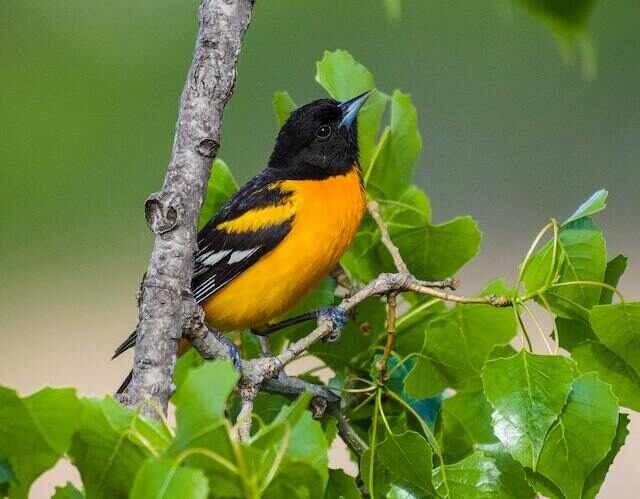
Overall Conclusion
Baltimore Orioles are known for their striking orange and black plumage and melodic songs. These birds are also known to have a diverse diet, consisting mainly of insects, fruits, and nectar.
Strawberry plants are a popular fruit-bearing plant found in many gardens and backyards. One may wonder if Baltimore Orioles eat strawberries, as these birds are known to eat fruits.
Although Baltimore Orioles are known to eat fruits, including grapes, oranges, and cherries, they are not known to eat strawberries.
Other birds, such as American Robins and Cedar Waxwings, are known to eat strawberries and may be more likely to forage for these fruits.
However, offering Baltimore Orioles a variety of fruits, nectar, and insects can still attract these beautiful birds to your backyard.
Feeding Baltimore Orioles can provide many benefits, such as aiding in their migration and increasing their survival rate.
It is important to take precautions when feeding them, such as using feeders that are easy to clean and avoiding offering sugary foods.
In conclusion, while Baltimore Orioles may not eat strawberries, offering them a diverse diet can still attract these beautiful birds to your backyard and provide many benefits to their survival.

